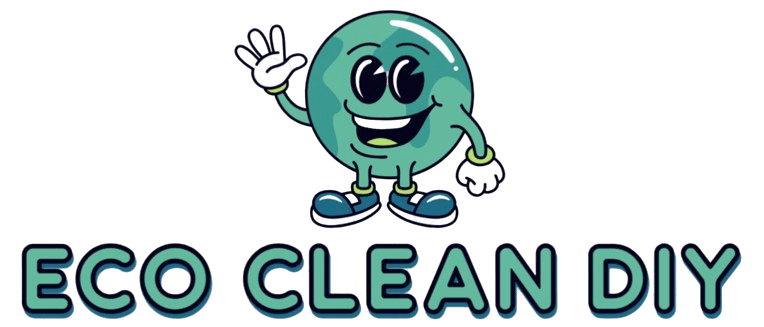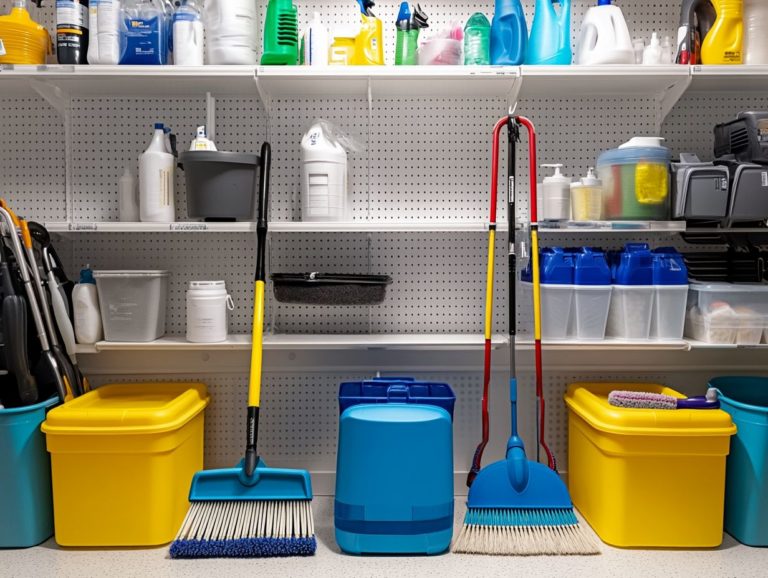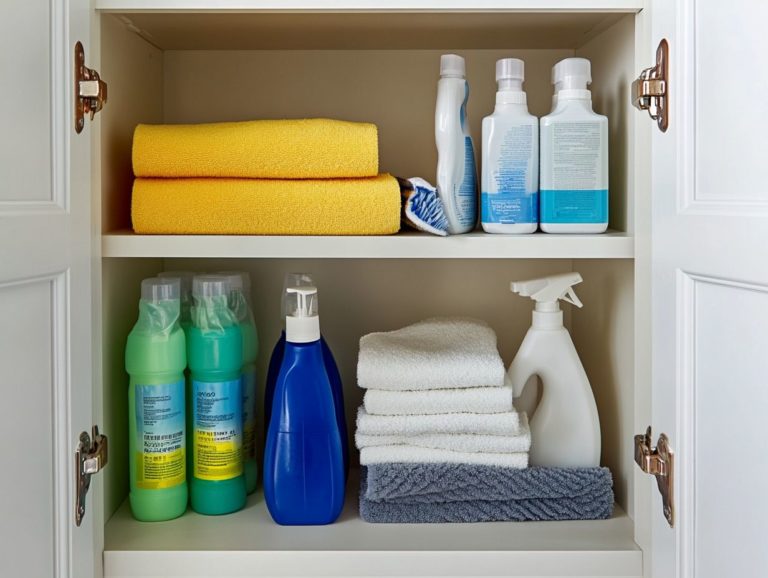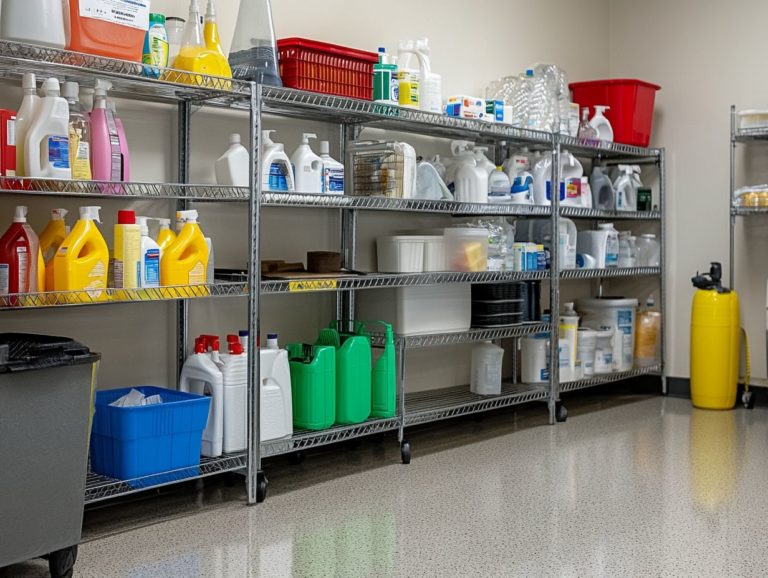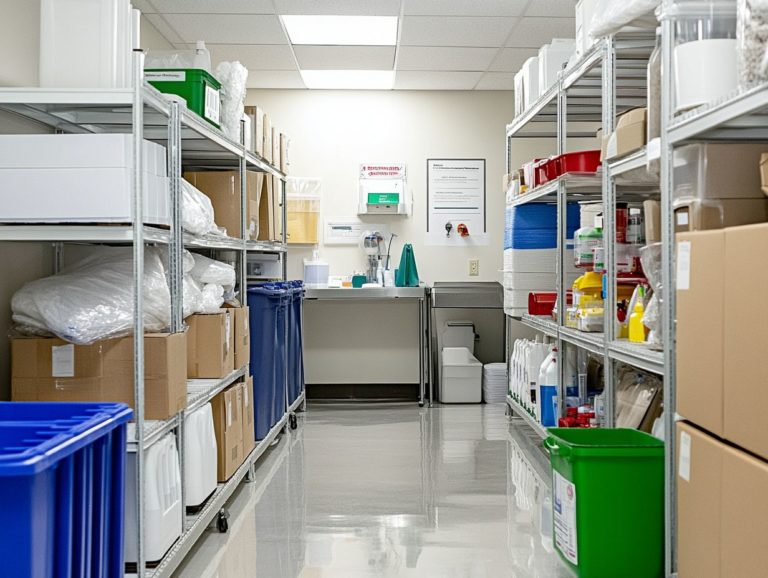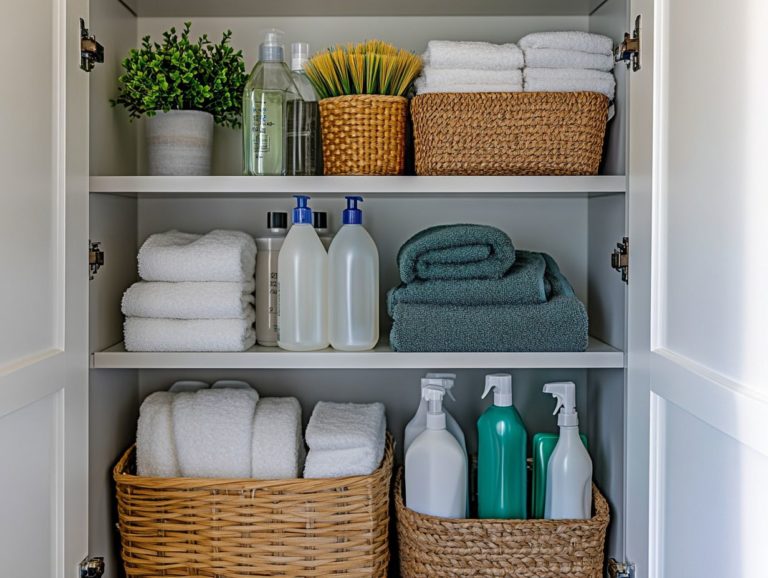Common Mistakes in Cleaning Supply Storage
Proper storage of cleaning supplies is essential for preserving their effectiveness and ensuring safety in your home or workplace. This includes using proper storage solutions like cabinets, bins, and baskets to organize your products.
You may not realize the importance of organizing these products, but neglecting this aspect can lead to common cleaning mistakes with serious repercussions.
From failing to label items to accidentally mixing cleaning products that don’t go together, improper storage can create health risks, surface damage, and even contamination.
This article delves into the common pitfalls of cleaning supply storage, the associated hazards, and offers practical tips to help you keep your cleaning supplies both safe and effective.
Contents
- Key Takeaways:
- Why Proper Cleaning Supply Storage is Important?
- What are the Common Mistakes in Cleaning Supply Storage?
- What Are the Risks of Improper Cleaning Supply Storage?
- How to Properly Store Cleaning Supplies?
- Frequently Asked Questions
- What are common mistakes people make when storing cleaning supplies?
- Should I store cleaning supplies in the same area as food or medicine?
- Is it okay to mix different cleaning products together for storage?
- Why is it important to properly label containers when storing cleaning supplies?
- Are cleaning supplies safe near children and pets?
- Is it safe to store cleaning supplies in unmarked containers?
Key Takeaways:
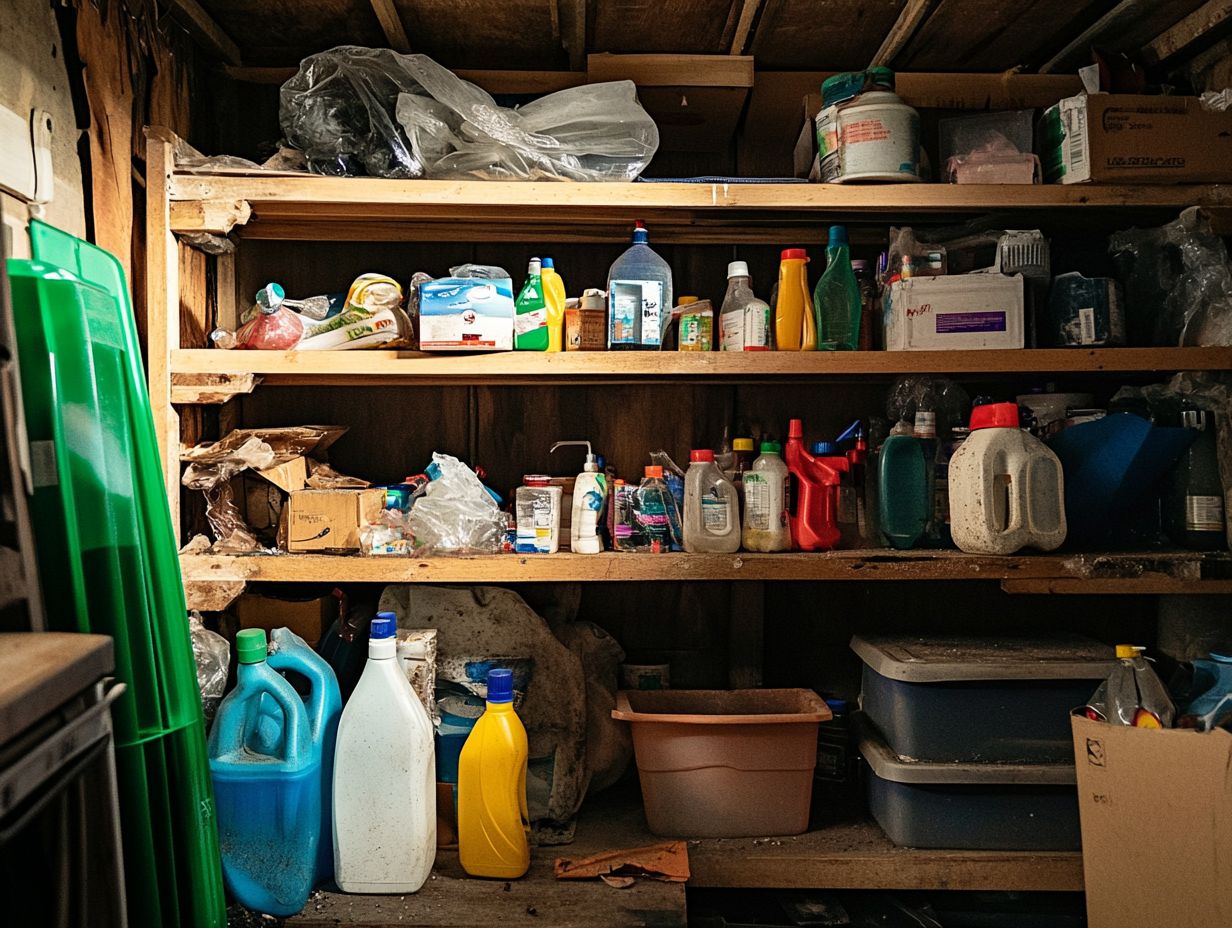
- Proper cleaning supply storage is crucial to maintain a safe and clean environment.
- Common mistakes include not labeling products, storing in inappropriate areas, and not checking expiration dates on cleaning products.
- Risks of improper storage include health hazards, chemical reactions, and contamination.
Why Proper Cleaning Supply Storage is Important?
Properly storing your cleaning supplies is essential for creating a safe and organized home environment. Using methods such as rotating items and employing storage techniques like a lazy Susan can save space and enhance accessibility.
When cleaning supplies are mismanaged, it can lead to accidents, especially in homes with children and pets, where easy access to hazardous chemicals presents significant health risks.
A well-organized storage system enhances the efficiency of your cleaning routines, making it easier for you to find essential tools like mops, brooms, vacuums, and other cleaning tools. This ultimately encourages regular maintenance and decluttering.
By adopting effective storage solutions, you can ensure that your cleaning products are clearly labeled and stored in designated areas. This minimizes the chances of cleaning mishaps and accidents while safeguarding the well-being of everyone in your household.
Experts like Gwen Cleaning & Organizing and Martha Stewart offer valuable tips and methods for organizing cleaning supplies.
What are the Common Mistakes in Cleaning Supply Storage?
In the realm of cleaning supply storage, it s easy to fall into common traps that could jeopardize both safety and efficiency. Alicia Sokolowski from AspenClean highlights the importance of avoiding organizing mistakes.
You might find yourself improperly labeling supplies, choosing unsuitable storage areas, or overlooking the critical task of checking expiration dates on cleaning products.
These mistakes can harm the effectiveness of your cleaning supplies and can also create potentially hazardous situations, especially with the chemicals frequently found in homes. Proper disposal methods should also be considered to prevent any lingering risks.
By recognizing these pitfalls, you can craft effective storage solutions that prioritize safety and accessibility, all while supporting a streamlined cleaning routine.
1. Not Labeling Products
One of the most significant missteps you can make when organizing your cleaning supplies is failing to label those products. Using clear labels and caddies can help you manage and organize these items.
This oversight can lead to confusion and even potential accidents, particularly with hazardous items that may pose risks to children and pets.
Clear labeling is essential for effectively communicating crucial information about chemical contents and specific safety warnings. Make sure the label includes important details like how to use it properly!
It should include details like proper usage instructions, storage recommendations, and first-aid responses in case of exposure.
By ensuring that your cleaning supplies are accurately labeled, you can drastically reduce the chances of accidental poisonings or injuries, especially in households where children and pets roam freely.
Moreover, proper labeling helps you select the right product for specific cleaning tasks, creating a more organized and safe cleaning environment.
Therefore, it’s vital to prioritize effective labeling practices in your home. Organizations like QC Design School and Advanced International Organizing Professional offer courses on effective labeling and organizing techniques.
Don’t wait! Start labeling your products today to ensure safety and avoid accidents.
2. Storing Products in Inappropriate Areas
Storing cleaning products in cabinets or storage spaces that are safe and out of children’s reach is essential.
Storing cleaning products in high cabinets or places reachable by children creates safety hazards. Martha Stewart and Melissa Poepping advise using locked cabinets for hazardous products.
This is particularly true for cleaning products that need careful handling and specific storage conditions.
These hazards pose significant risks, such as accidental poisoning or chemical burns, which can be especially alarming in homes with young children or pets. Act now! Organize your cleaning supplies to keep your family safe by placing them in secure, designated areas, such as locked cabinets or storage rooms that are out of reach.
Using clear, labeled bins or caddies can also help with proper placement, making it easy to identify and keep track of your supplies while ensuring that harmful substances are not inadvertently accessed. Regularly reviewing and updating your storage strategies to comply with safety guidelines, like those established by the Environmental Protection Agency (EPA), can further enhance the protection of everyone in your household and the environment.
3. Not Checking Expiration Dates
Neglecting to check the expiration dates on your cleaning supplies can lead you to use ineffective products, compromising not just the efficiency of your cleaning efforts but also potentially introducing safety risks if chemicals degrade or react poorly over time.
Regularly monitoring these dates is essential to ensure that your cleaning routine remains both effective and safe. Trinity Commercial Cleaning emphasizes the importance of managing expiration dates to maintain an efficient cleaning routine.
Expired cleaners might disappoint you by failing to disinfect surfaces, allowing bacteria to thrive, while some expired chemicals could even become hazardous, increasing the risk of dangerous reactions.
To manage this crucial task, consider organizing your cleaning products by their expiration dates, placing newer items behind older ones. This method helps you use the older supplies first, reducing waste and enhancing safety.
Label each item with its expiration date to remind you easily, making it easier for you to maintain an effective and safe cleaning collection.
4. Mixing Chemicals
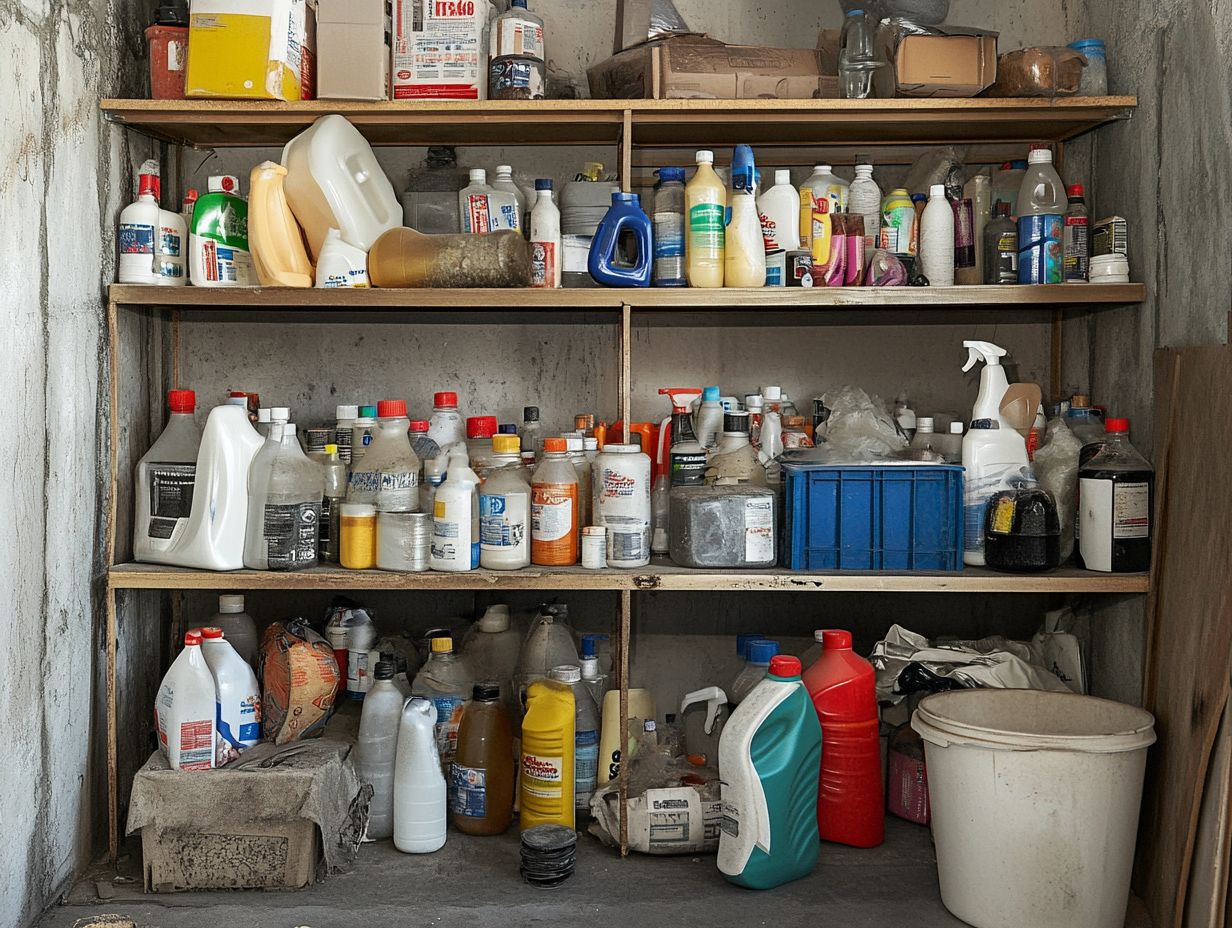
Mixing cleaning chemicals can unleash dangerous reactions that pose significant health risks. It s essential for you to understand which products are safe to combine and which should always be kept separate to prevent accidents and ensure safety in your home.
You may not realize that even everyday household items can lead to toxic fumes, which are harmful gases that can make you sick, or chemical burns when mixed improperly. For example, combining bleach with ammonia produces chloramine vapors that can be harmful when inhaled.
To safeguard against these dangers, take the time to read labels carefully and follow the manufacturer’s instructions for each product. Marilee Nelson, an Environmental Consultant, advises closely following safety instructions to prevent accidents and ensure proper disposal.
Storing cleaning supplies in clearly labeled, secure containers well out of reach of children and pets is crucial. Creating a designated cleaning area and ensuring good ventilation while using these products can further reduce risks, helping you foster a safer environment in your home.
Don t risk your family’s safety! Always read labels before mixing any cleaning products.
5. Not Having a Proper Storage System
Having a proper storage system involves organizing products by frequency of use and type, ensuring everything has its place.
Without a proper storage system for your cleaning supplies, you may find yourself in a bit of chaos. It can be challenging to locate essential products at a moment’s notice, which disrupts your cleaning routine. This disorganization can also pose safety risks if hazardous materials aren t stored correctly.
To create an efficient cleaning supply storage system, start by categorizing your products according to how frequently you use them and their type. For even more organization, consider using shelves, rotating trays that help organize items, and space-saving storage techniques.
For example, keep daily-use items like glass cleaners and disinfectants within easy reach. On the other hand, seasonal products can be tucked away for later use. Labeling shelves or bins clearly is a smart practice, allowing for quick identification when you need something in a hurry.
Safety should always be at the forefront of your mind. Make sure hazardous materials are securely locked away and out of reach of children and pets. Utilize cabinets or higher shelves for potentially dangerous substances. Ensure that all supplies are stored in a cool, dry place to maintain their effectiveness and prevent any chemical mishaps.
What Are the Risks of Improper Cleaning Supply Storage?
When you don t store your cleaning supplies properly, you open the door to various risks. Improper management and organization can lead to these hazards.
These include health hazards from exposure to toxic chemicals, the potential for dangerous chemical reactions, and contamination of surfaces or other products. Each of these issues can significantly compromise the safety and cleanliness of your home.
1. Health Hazards
Health hazards from cleaning supplies often arise from improper storage, which can expose children and pets to harmful chemicals. A lazy Susan, higher shelves, and secure containers can help mitigate these risks.
This exposure can lead to accidents and serious health issues that you could easily prevent with proper organization and safety measures.
Many common household cleaners contain toxic substances like ammonia and bleach. Experts recommend using non-toxic alternatives where possible.
When ingested or inhaled, these chemicals can cause respiratory problems, skin irritations, or even severe reactions in sensitive individuals. Consider this: young children are naturally curious and may inadvertently ingest or spill these products, creating potentially life-threatening situations. Pets are also at risk, as they explore their surroundings with their mouths, making them vulnerable to poisoning.
Keep your loved ones safe by securing your cleaning supplies in high cabinets or using child-proof locks. Proper storage techniques like locking cabinets and clear bins can further ensure safety.
By taking these steps, you create a much safer home environment for both your little ones and furry companions.
2. Chemical Reactions
Improper storage and mixing of chemicals can lead to dangerous reactions. It s crucial to understand safe combinations and follow safety tips.
Chemical reactions that stem from improperly stored cleaning supplies can lead to toxic fumes or even explosive situations. It s crucial to understand how to safely compartmentalize hazardous products and recognize the risks associated with mixing incompatible chemicals. Following proper storage solutions and organizing methods helps prevent such risks.
For example, when you combine bleach with ammonia, you create chloramine vapors, harmful gases that can be detrimental to your respiratory system and can lead to serious health issues. Similarly, mixing acids with bases can trigger vigorous reactions, generating heat and causing splattering that may pose a danger to you and your surroundings.
To prevent such hazards, you must remain vigilant in following safety protocols. This includes storing cleaning agents in clearly labeled containers, keeping them away from direct sunlight and heat sources.
Maintaining an organized storage area and regularly checking for expired products is essential for ensuring a safer environment. Implementing decluttering techniques and proper placement of supplies will further enhance safety.
Your awareness and education on proper handling not only protect you but also contribute to the overall safety of homes and workplaces.
3. Contamination
Not storing supplies properly can cause cross-contamination the transfer of germs from one surface to another and ineffective cleaning. This ultimately compromises the hygiene and safety standards within your home.
When you place cleaning solutions haphazardly in cabinets or leave them unrefrigerated, their effectiveness can wane. This allows harmful bacteria to thrive, increasing not only the risk of spreading pathogens but also the chances of accidents, such as spills or improper mixing of chemicals.
To counter these potential issues, it’s crucial to set up a clean and organized storage system for your supplies right away. By utilizing designated containers, clearly labeling products, and ensuring everything is securely closed, you can uphold safety protocols. An orderly storage environment enhances visibility and accessibility, reinforcing the overall effectiveness of maintaining a hygienic living space.
How to Properly Store Cleaning Supplies?
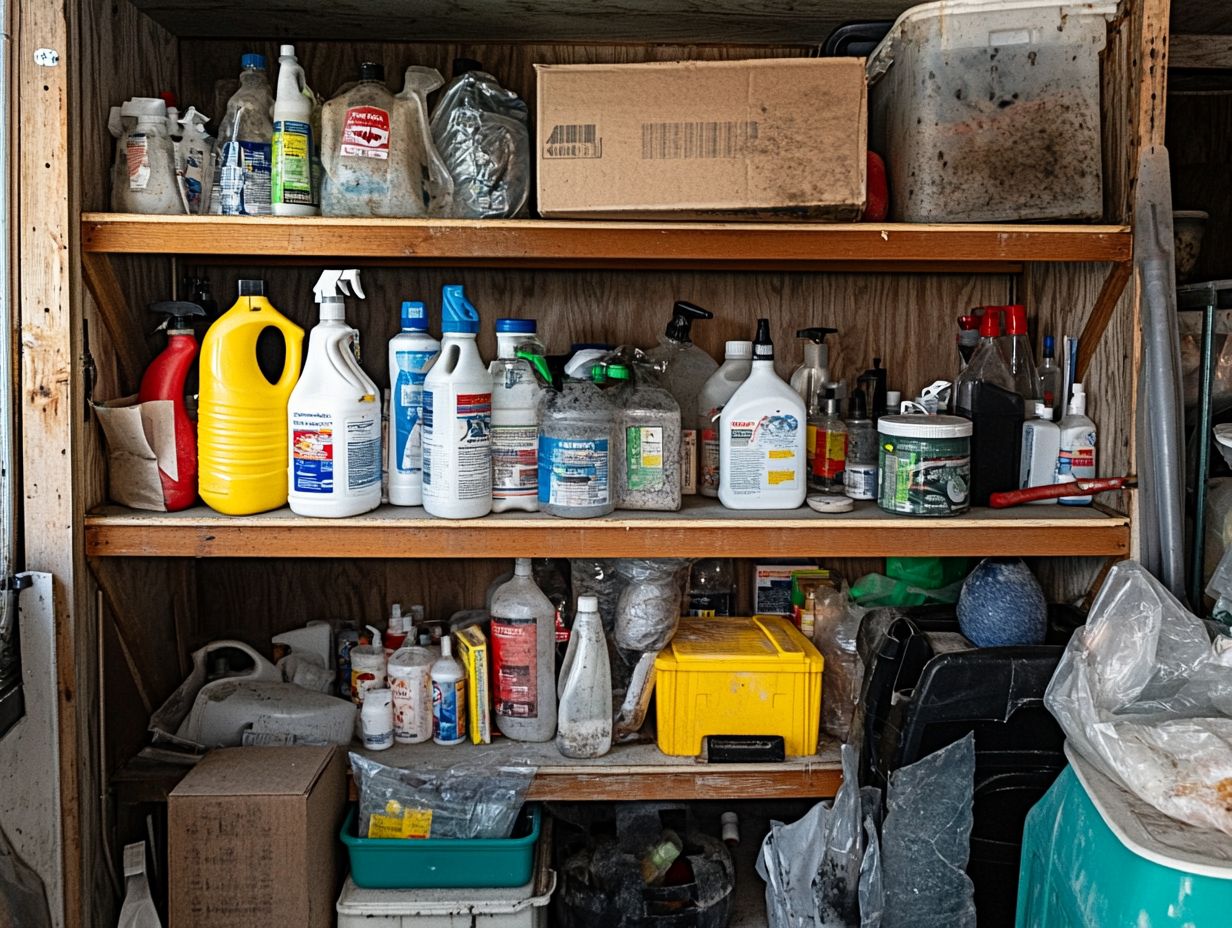
Properly storing your cleaning supplies requires a thoughtful approach that emphasizes both safety and organization. By ensuring that hazardous products are securely out of reach of children and pets, you create a safer environment.
Keeping your cleaning tools like vacuums, mops, and brooms accessible helps you tackle maintenance tasks efficiently whenever they arise.
1. Label Products Clearly
Clearly labeling your cleaning products is a crucial step in ensuring safety and organization within your home. This practice allows everyone in the household to quickly identify the contents and potential hazards associated with each item, helping to avoid accidents and misuse. Experts like Martha Stewart and Melissa Poepping recommend using clear, easy-to-read labels for better management.
An effective label should include essential information, such as the product name, its intended use, and specific handling instructions that emphasize safety precautions. Using easy-to-read fonts and a clear layout enhances usability, making it simple for anyone to scan the label and grasp the information at a glance.
Incorporating symbols or color codes can also assist in categorizing products according to their purpose or hazard level. By implementing these best practices in labeling, you contribute to a safer home environment and promote responsible usage of cleaning supplies, ultimately minimizing the risk of harmful incidents.
2. Store Products in a Cool, Dry Place
Storing your cleaning supplies in a cool, dry place is essential for maintaining their effectiveness and safety. Extreme temperatures and humidity can degrade the chemicals, potentially creating hazardous conditions or diminishing their cleaning power. Consider using lazy Susans or rotating shelves for better access and organization.
These environmental factors are crucial in ensuring that your products perform as they should. For example, keep your cleaning agents in cabinets away from direct sunlight, as exposure to UV rays can alter their chemical composition.
Avoid areas like basements or garages, where temperatures and moisture levels can fluctuate unpredictably; those are not the best choices for storage. Instead, think about using an interior closet or pantry that consistently stays dry and cool.
This method keeps your cleaning supplies fresh longer and makes your home safer by keeping potentially harmful chemicals out of reach of children and pets.
Start organizing your cleaning supplies today to create a safer and more efficient home.
3. Check Expiration Dates Regularly
Regularly checking the expiration dates on your cleaning supplies is essential to ensure your products are effective and safe for use. This practice helps you avoid the risks tied to outdated or degraded chemicals.
By prioritizing this simple yet crucial task, you safeguard your health and elevate the efficiency of your home cleaning routines. To monitor expiration dates effectively, consider organizing your cleaning supplies for easy visibility. Group products by their expiration dates and position those that expire soonest at the front. Experts from AspenClean and Trinity Commercial Cleaning recommend this approach.
Labeling your shelves or storage bins with date ranges can streamline the process, making it easier to keep track. When it comes to expired cleaning supplies, safe disposal is key. Follow local regulations for hazardous waste disposal or participate in community collection events to ensure you dispose of chemicals responsibly.
4. Keep Chemicals Separated
Keep your cleaning chemicals separate to stay safe and protect your loved ones! This prevents dangerous chemical reactions and ensures the safety of everyone in your household, especially if you have children or pets who might inadvertently mix products.
To effectively manage these hazardous substances, organizing is key. Designate specific areas or containers for different types of chemicals, such as disinfectants (cleaning products that kill germs), degreasers, and solvents, to avoid cross-contamination. Use storage bins and caddies for better organization.
Using clearly labeled, child-proof containers can significantly reduce the risk of accidents. Store your cleaning products in a cool, dry place, away from direct sunlight and heat sources, as certain conditions can lead to hazardous fumes or reactions. Experts like Environmental Consultant Marilee Nelson emphasize the importance of proper storage conditions.
Regularly check for expired items and dispose of any unused chemicals properly; maintaining a safe cleaning supply environment is crucial for your peace of mind.
5. Have a Storage System in Place
Implementing a structured storage system for your cleaning supplies enhances organization and accessibility. This makes it easier for you to maintain a consistent cleaning routine while ensuring that safety measures are upheld.
A well-organized space saves valuable time and promotes safety by reducing the risk of accidents caused by clutter. Start by categorizing your supplies based on how often you use them or by the type of cleaning tasks they are intended for think daily, weekly, or seasonal products. Experts like QC Design School and Advanced International Organizing Professional recommend this technique.
Utilize shelving units designed to accommodate various heights and weights, placing heavier items on lower shelves for easy access. Clear storage bins, labeled with their contents, will streamline the process, allowing for quick identification of what you need for specific tasks. By designating a specific location for each item, you ll cultivate the habit of returning supplies to their rightful place, contributing to a consistently tidy environment. Partnering with professionals like Alicia Sokolowski can provide valuable insights into efficient storage techniques.
Frequently Asked Questions
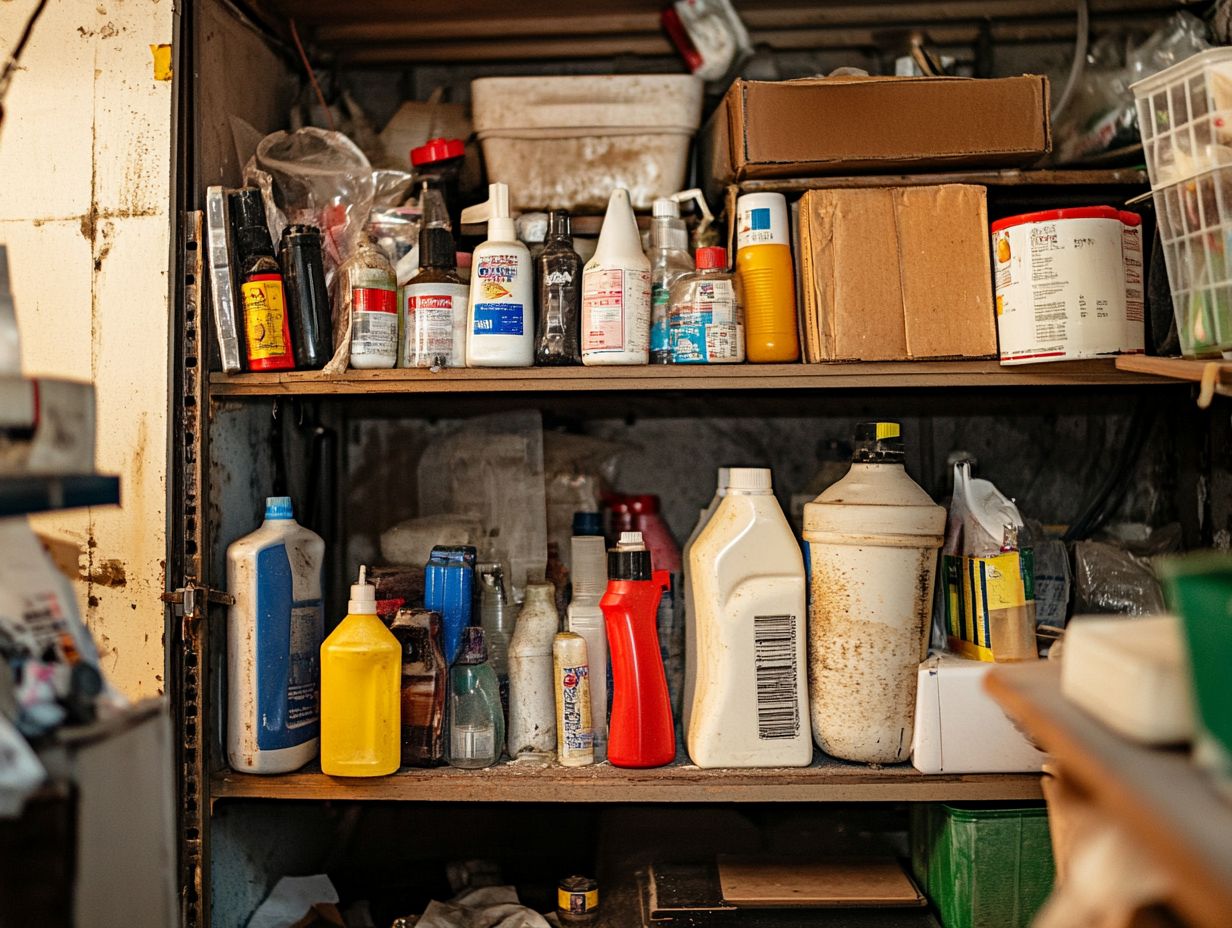
What are common mistakes people make when storing cleaning supplies?
Some common mistakes include storing supplies in hot or humid areas, not properly labeling containers, and not securing hazardous chemicals.
Should I store cleaning supplies in the same area as food or medicine?
No, it is not recommended to store cleaning supplies in the same area as food or medicine. Chemicals from the cleaning supplies can contaminate these items, posing a health risk.
Is it okay to mix different cleaning products together for storage?
No, it is never okay to mix different cleaning products together for storage. This can cause dangerous chemical reactions and potentially release harmful fumes. This is one of the common cleaning mistakes that many people make. Always keep chemicals separate to avoid any hazards.
Why is it important to properly label containers when storing cleaning supplies?
Properly labeling containers prevents accidental misuse or ingestion of cleaning products. This simple step helps you quickly identify each product, saving you time and avoiding hazards.
Are cleaning supplies safe near children and pets?
Cleaning supplies should always be kept out of reach of children and pets. Many cleaning products have chemicals that can be dangerous if swallowed or if they touch the skin.
Is it safe to store cleaning supplies in unmarked containers?
Storing cleaning supplies in unmarked containers is risky. You could easily confuse them with something else, leading to accidents. Follow safety guidelines for proper labeling and storage to keep everyone safe.
Taking these precautions is essential to ensure the safety of your family and pets. Be proactive in safeguarding your home by properly labeling and storing your cleaning supplies.
